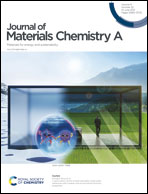A novel carbon aerogel enabling respiratory monitoring for bio-facial masks†
Abstract
People suffering from chronic respiratory diseases caused by air pollution need air filters simultaneously capable of high-efficiency filtration and respiration monitoring. However, constructing desirable filters to realize effective and durable capture of ultrafine particles as well as collection of real-time respiratory information is still particularly challenging. Herein, we report an ultralight, super-elastic hard carbon aerogel (s-HCA) as a piezoresistive sensor for a respiratory monitoring facial mask made of s-HCA/zein nanofibrils. The s-HCA displays super-elasticity and excellent compressive strength at a low density, as well as outstanding piezoresistive detective sensitivity and ranges. The resulting facial mask displays excellent filtration performance including high particulate efficiency and ultralow airflow resistance, as well as good moisture transferability. More significantly, ability of simultaneously monitoring the real-time respiratory process of filtration is incorporated into the facial mask. This study does not only lead to a novel carbon aerogel and broaden the application of carbon aerogels, but also provides a new strategy for the design of multifunctional facial masks. It is particularly significant for more patients under the situation of lack of costly respiratory equipment during the pandemic period.



 Please wait while we load your content...
Please wait while we load your content...